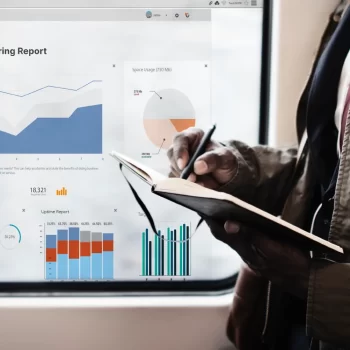Navigating the modern IT environments requires a robust strategy when it comes to managing virtual machines. As businesses increasingly rely on virtualization, the importance of Virtual Machine (VM) monitoring becomes undeniable. VM monitoring is a major part of overall IT infrastructure management.
The advantages of VM monitoring tool range from performance and security to strategic planning, and more. Let’s look at them in-depth.
Related article: Why VM Monitoring is a Game-Changer for Enterprises
10 Most Valuable Benefits of VM Monitoring tool
Higher uptime
VM monitoring tool ensures that virtual servers hosting VMs achieve high uptime and maintain peak performance, which is crucial for the smooth operation of business applications. It enables early detection of potential performance degradation or outages for IT professionals to take preemptive action.
It reduces the likelihood of performance bottlenecks so that VMs run reliably. Plus, the assurance of high uptime and peak performance translates into enhanced customer satisfaction and loyalty, as users experience minimal disruptions and consistently high-quality service.
Performance insights

Gaining detailed insights into the performance of a virtual environment allows IT teams to identify and troubleshoot issues before they affect end users. VM monitoring tools provide comprehensive data on resource usage, application performance, and system health, enabling a deeper understanding of the environment.
Such a level of insight supports faster problem resolution and helps maintain a high-quality user experience. These insights also empower IT teams to make data-driven decisions regarding infrastructure improvements and investments, ensuring that the virtual environment is always aligned with the organization’s operational goals.
Informed capacity planning
Capacity planning provides the analytics needed to allocate VMs optimally across host servers. By understanding current resource consumption and predicting future demands, IT managers can avoid overprovisioning and underutilization. The strategic allocation of resources ensures that each VM operates without wasting valuable IT resources.
Beyond immediate operational benefits, informed capacity planning also contributes to long-term sustainability efforts. Organizations can lower their energy consumption and carbon footprint, supporting environmental goals by optimizing the use of hardware and reducing the need for unnecessary physical servers.
Unified management console
Managing physical and virtual components from a single console streamlines the administration of IT resources. This centralized management approach enhances visibility across the infrastructure, making it easier to monitor and adjust resources as needed. A unified console simplifies the complex task of managing a diverse IT environment, allowing for more streamlined operations.
The consolidation of control reduces the learning curve for IT staff, enabling them to manage the infrastructure more intuitively and with greater agility. It enables a quicker response to issues and allows for more strategic IT planning and execution.
Agentless monitoring
Agentless monitoring solutions offer a hassle-free setup and management experience, reducing the overhead associated with traditional agent-based systems. It minimizes the impact on system performance and eliminates the need for additional software on each VM. The ease of deployment and reduced maintenance make agentless monitoring a breeze for organizations.
The agentless model also supports a broader compatibility range, making it easier to integrate with existing and future technologies within the IT ecosystem. The flexibility ensures that organizations can adapt to new technologies without revamping their monitoring infrastructure.
Enhanced security posture

Monitoring VMs contributes to an organization’s security posture by providing early warning of potential threats. It includes detecting anomalies that could indicate a breach, such as unusual network traffic or unauthorized access attempts. By enabling rapid response to these threats, VM monitoring tool helps protect sensitive data and maintain the integrity of the virtual environment.
The continuous improvement of security protocols, informed by monitoring insights, also strengthens an organization’s defense mechanisms over time. This ongoing enhancement of security measures ensures that the virtual infrastructure remains resilient against newer cyber threats, safeguarding assets and maintaining trust with stakeholders.
Optimized resource utilization
Optimizing the utilization of resources like CPU, memory, and storage is a key benefit of a VM monitoring tool. It identifies underperforming VMs and reallocates resources to where they are needed most. This optimization ensures that each VM has sufficient resources to perform its tasks, improving the overall virtual environment.
Moreover, it leads to cost savings by eliminating the demand for additional physical hardware and minimizing energy consumption. Organizations can achieve more with their existing resources, aligning IT expenditures with actual needs and environmental sustainability goals.
Proactive issue resolution
The real-time alerts generated by VM monitoring tools empower IT teams to act quickly in resolving issues. This capability to address problems before they escalate prevents potential outages and contributes to a smoother, uninterrupted operation of IT services. Proactive issue resolution is crucial for maintaining operational stability and preventing minor issues from becoming huge problems.
Additionally, it enhances the IT department’s reputation within the organization, showcasing the team’s ability to manage and mitigate risks.
Cost savings

By reducing downtime, optimizing resource allocation, and preventing security breaches, VM monitoring directly contributes to cost savings. These translate into lower operational costs, reduced need for emergency interventions, and better utilization of existing resources.
The financial benefits of a VM monitoring tool certainly make it a valuable investment for organizations looking to maximize their IT budget.
Higher SLA compliance
Maintaining high performance and availability through VM monitoring helps organizations meet SLAs with customers. This adherence to SLAs avoids financial penalties and also builds trust in the services. Achieving and maintaining SLA compliance is important for customer satisfaction and the long-term success of any service-oriented business.
Also, the data collected through a VM monitoring tool can be used to report on SLA performance metrics, providing transparent communication with customers and identifying areas for service improvement. Such transparency can differentiate an organization across markets.
Related article: Why Effective Wi-Fi Monitoring is Critical in Remote Environments
Conclusion
The role of a VM monitoring tool is foundational and forward-looking. It provides the necessary insights and controls to manage virtual environments so that they meet the operational standards required today. For organizations looking to maintain a competitive edge through their IT operations, investing in advanced VM monitoring tools and practices is certainly a no-brainer.



















